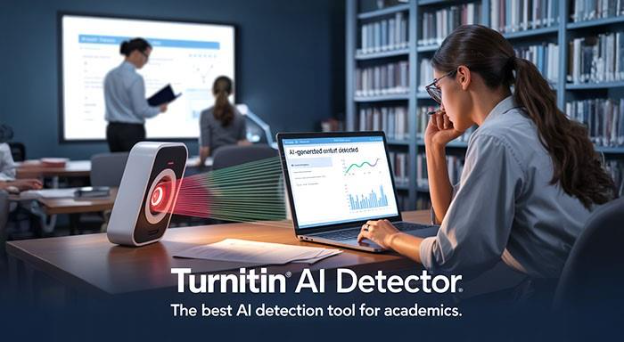In the modern educational landscape where AI technology impacts academic integrity standards, Turnitin AI Detector has gained traction as a vital platform for institutions and educators. With generative AI tools becoming greatly advanced, the demand for accurate AI detection has never been greater. This blog delves deep into whether Turnitin AI Detector is the most reliable AI detection platform in 2026. It explores its methodology, capabilities, and practicality. At the end of the blog, you will know how Turnitin incorporates AI detection within its wider suite of platforms, ascertaining a complete approach toward academic integrity.
With more students attempting to bypass detection algorithms through advanced humanizer tools like Humbot AI, the need for platforms like Turnitin has increased exponentially.
What is Turnitin?
Turnitin is a complete digital platform purpose-built to maintain academic integrity and improve writing quality. Built years ago, it provides a comprehensive range of tools, including the following:
- An advanced tool that checks similarity of content against an external database.
- Feedback Studio that maintains comments of the instructor in a simplified way.
- Authorship investigation for contract-cheating detection
- Advanced AI detector that flags texts as likely created by prominent AI models like ChatGPT, DeepSeek, Claude, etc.
The feature of AI detection is only one of the components in the much more comprehensive system of Turnitin, helping educators to get diverse review layers.
What is Turnitin AI Detector?
The AI detector tool offered by Turnitin is a robust platform that identifies content that may have been generated using AI content generation models such as GPT-4. Released as a component in a much more expansive suite of Feedback Studio upgrades in the early part of 2024, it examines submitted content, flags suspicious texts, and gives an AI confidence score.
The key features of the platform are described as follows:
- Users can leverage the analysis in real-time within both the enhanced and classic similarity reports.
- The tool highlights passages with the AI content generation indicators.
- The platform ensures multilingual support, which includes specialized Spanish and Japanese models.
By incorporating this AI detection, Turnitin reinforces its ongoing commitment to academic integrity under a centralized platform. It upholds its commitment to detect various forms of academic dishonesty and help faculties ensure a much more honest and fairer learning environment.
Key Highlight of the Turnitin AI Detector
1. AI Confidence Score
- It provides a rating related to the probability of the content to be AI-created.
- It ensures percentage-driven feedback for fast assessment.
2. Flagged Passages
- Highlights particular paragraphs or sentences.
- Enables faculties to pay closer attention to the flagged sections.
3. Multilingual Support
- Supports multiple languages like Japanese, English, Spanish, etc.
- Language-driven models rigorously trained on expected AI outputs.
4. Smooth Incorporation
- Seamlessly works within the existing similarity detection platforms or reports.
- There is no need for a separate interface. It ensures unified dashboards for all verification.
5. Consistent Model Updates
- With regular updates and algorithm enhancement, it easily adjusts to the newest AI model releases, such as GPT-4o-mini.
- Thus, it ascertains that the detection remains as effective as possible against advanced generative AI models.
Mechanics of Turnitin AI Detector
The core algorithm of the Turnitin AI Detector integrates ML (machine learning) classifiers with linguistic analysis. The streamlined workflow is mentioned as follows:
1. Extraction of Text
- Submitted content is automatically parsed as well as normalized.
2. Analysis
- The platform detects core AI patterns in the content, like burstiness, perplexity, and syntactic consistency.
3. Comparison with Models
- Compares the content features against stored datasets from established AI outputs.
4. Assigns a Confidence Score
- It creates a confidence score that signals the possibilities of AI content generation.
5. Creation of Reports
- Incorporates AI indicators among the details mentioned in the similarity reports.
This comprehensive approach comprising multiple steps makes sure that Turnitin examines content both at the sentence level and holistically, enhancing accuracy of detection.
Advantages and Disadvantages of Turnitin AI Detector
Benefits
- Complete Coverage: An essential component of a complete suite of academic integrity tools.
- Greater Levels of Accuracy: Expert trials and internet reports suggest that the platform is as much as 98% accurate in controlled tests.
- User-friendly Platform: The users do not need to undergo any additional setup or login process if they are already an existing member of Feedback Studio.
- Multi-linguistic Models: Personalized detection for submissions in specialized languages.
- Consistent Updates: Consistently evolves with the prominent generative AI models in the market.
Disadvantages:
- Possibilities of False Positives: It can occasionally misclassify human-written text as AI-generated content.
- Limited Understanding of Context: The platform can incorrectly flag AI in the technical documentation or formal writing.
- Subscription-based Access: In order to gain full accessibility to its features, users need an institutional subscription.
- Reliance on Training Information: Effectiveness is associated with the training datasets containing biased data themselves.
Right Practices for Leveraging Turnitin AI Detector
To enhance the overall effectiveness of the Turnitin AI Detector, it is important for the educators to:
- Use Several Tools: Users must utilize diverse AI detection platforms alongside the conventional similarity checks. If you are getting high scores in 4/5 tools, then you can be confident that the content is AI generated.
- Context Review: It is important for the educators to interpret AI scores in the context of assignment guidelines and writing styles.
- Keep Students Informed: Learners must be closely informed about the AI policies, and motivate them to use it ethically.
- Regulate Thresholds: Try customizing the thresholds of the confidence score to balance out specificity and sensitivity.
- Continuous Updates and Training: You must remain updated on the new releases in the generative AI industry and see whether corresponding feature updates are there in Turnitin.
How Turnitin Compares with Standalone AI Detection Platforms?
Comparing the Turnitin AI Detector with standalone AI detection services reveals several advantages, as shown in the table:
Turnitin AI Detector vs Third-Party AI Detection Tools
| Feature | Turnitin AI Detector | Standalone AI Detectors |
| Detection Focus | It integrates smoothly with LMS platforms, including Blackboard or Canvas. | It concentrates only on AI detection. |
| Depth of Data | Accessibility to vast institutional and academic databases for cross-referencing. | Limited-to-no accessibility to academic databases. |
| Integration with Learning Management System | Accuracy can vary from content to content. | Standalone platforms have limited or no integration compatibility with LMS platforms. |
| UI | Offered within the Turnitin institutional license. | It might provide specialized dashboards for in-depth AI insights. |
| Subscription Model | Offered within the Turnitin institutional license. | Incorporated into Feedback Studio of Turnitin; no need of a separate dashboard. |
| Accuracy | Believed to be highly accurate with occasional false positives for technical content | Accuracy can vary from content to content. |
Deploying Turnitin AI Detector in the Academic Settings
1. Set up clear policies.
- Determine acceptable levels of AI assistance.
2. Deploy Pilot Tests
- Begin with a smaller group to fine-tune settings.
3. Faculty Training
- The instructors must be informed and educated on how to interpret AI reports.
4. Collect Feedback
- Gather feedback from instructors and students to enhance usage.
A structured rollout makes sure that integration is smoother and harmonious and concerns are addressed seamlessly.
The Future of Academia: What Can We Expect in AI Detection?
As popular AI models evolve further, detection platforms must evolve with them. Essentially, they need to:
- Integrate sophisticated linguistic markers.
- Improve cross-modal analysis (e.g., images, code).
- Incorporate ethical AI frameworks.
Various reports suggest that Turnitin is researching multi-dimensional detection already and is looking forward to incorporating video and voice analysis by 2026.
FAQs for Turnitin
Q: Is Turnitin AI Detector capable of differentiating between AI-generated content and genuine student drafts?
A: One of the key highlights of the platform is AI Confidence Score. It specially focuses on the typical generative model patterns. It is important for the instructors to ensure a final review of the flagged sections before making the final decision.
Q: Does the platform use submissions to carry out AI model training?
A: The short answer is no. As per the platform’s policies, the submissions are only utilized for detection. In this way, institutions can protect their confidential documents under institutional agreements.
Q: Do all subscription plans include Turnitin AI Detector??
A: No, the AI detection is included only in the institutional plans that include Feedback Studio. However, the pricing structure of the platform can vary, and things can change in the future.
Q: Is Turnitin AI Detector reliable in 2026?
A: The Turnitin AI Detector ensures high accuracy in AI content detection. Reports suggest that its accuracy in recognizing AI-created content is as high as 98%. However, the results can change as per the context and writing style.
Q: Is it possible for the students to mislead the AI detection of the platform through paraphrasing tools?
A: While a few paraphrasing tools like Jasper AI are advanced, Turnitin is a capable tool with abilities to analyze deeper linguistic syntax and patterns. Surface-level rewording is not sufficient to successfully evade AI content detection.
Conclusion
As generative AI consistently evolves, academic institutions need dependable tools to ensure overall integrity. The AI detector of Turnitin combined with a wide set of feedback and assessment platforms ensures a reliable solution in 2026. Its complete coverage, top-level accuracy, and smooth integration makes it a popular choice in the complex landscape of AI detection. However, it is important for the users to be mindful of the limitations of the platform like contextual nuances and false positives. By integrating Turnitin AI Detector with robust pedagogical practices, educators can ensure overall academic honesty while overcoming challenges posed by AI-powered writing.
Related Post:
Venice AI: The Privacy-First Platform Revolutionizing AI Conversations




%201.png)

%201.png)

%201.png)

